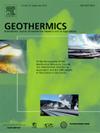川西高原复杂地形下地热潜热带探测与约束:多源时序遥感数据融合
IF 3.5
2区 工程技术
Q3 ENERGY & FUELS
引用次数: 0
摘要
地热能是一种具有巨大潜力的可持续和可再生资源,特别是在地形复杂的地区,如高原地区。然而,由于地形因素的影响和遥感数据分辨率的限制,在这些地区准确探测地热异常存在挑战。为了应对这些挑战,本研究提出了一种集成多源、多时相遥感数据的新方法。该方法利用MODIS的高时间分辨率、Landsat 8的高空间分辨率和ALOS数据的地形参数。该方法将动态多时相阈值和地形校正相结合,有效地区分了地热信号和太阳辐射引起的伪热异常。结果表明,多源遥感数据的整合能够准确识别精细尺度的热异常,符合区域构造热控机制。坡度、坡向和遮荫等地形因子对地表温度的空间分布有显著影响。经过地形校正后,该模型消除了36% - 45%的伪热异常区域,对实际温泉位置具有较高的验证精度。这些发现强调了地形校正在地热异常探测中的重要性。该方法有效减少了虚假热异常,提高了地热区识别精度,提高了遥感技术在地热勘探中的适用性。此外,它还为评估地形复杂地区的可持续能源提供了一个强有力的框架。本文章由计算机程序翻译,如有差异,请以英文原文为准。
Detection and constraints of geothermal latent heat zones under the complex terrain of the Western Sichuan Plateau: A fusion of multi-source temporal remote sensing data
Geothermal energy is a sustainable and renewable resource with significant potential, particularly in regions with complex topography, such as high plateaus. However, accurately detecting geothermal anomalies in these areas presents challenges due to the influence of topographic factors and the resolution limitations of remote sensing data. To address these challenges, this study proposes a novel method that integrates multi-source and multi-temporal remote sensing data. The method leverages the high temporal resolution of MODIS, the high spatial resolution of Landsat 8, and topographic parameters derived from ALOS data. By combining dynamic multi-temporal thresholding and topographic correction, the approach effectively distinguishes geothermal signals from pseudo-thermal anomalies induced by solar radiation. The results demonstrate that the integration of multi-source remote sensing data enables the accurate identification of fine-scale thermal anomalies, consistent with the regional tectonic heat-control mechanisms. Topographic factors, including slope, aspect, and hillshade, are shown to significantly influence the spatial distribution of surface temperature. Following topographic correction, the model eliminates 36 %–45 % of pseudo-thermal anomaly areas, with high validation accuracy against actual hot spring locations. These findings underscore the critical importance of topographic correction in geothermal anomaly detection. By effectively reducing false thermal anomalies and enhancing the precision of geothermal zone identification, this integrated approach improves the applicability of remote sensing techniques for geothermal exploration. Furthermore, it provides a robust framework for assessing sustainable energy resources in regions with complex terrain.
求助全文
通过发布文献求助,成功后即可免费获取论文全文。
去求助
来源期刊

Geothermics
工程技术-地球科学综合
CiteScore
7.70
自引率
15.40%
发文量
237
审稿时长
4.5 months
期刊介绍:
Geothermics is an international journal devoted to the research and development of geothermal energy. The International Board of Editors of Geothermics, which comprises specialists in the various aspects of geothermal resources, exploration and development, guarantees the balanced, comprehensive view of scientific and technological developments in this promising energy field.
It promulgates the state of the art and science of geothermal energy, its exploration and exploitation through a regular exchange of information from all parts of the world. The journal publishes articles dealing with the theory, exploration techniques and all aspects of the utilization of geothermal resources. Geothermics serves as the scientific house, or exchange medium, through which the growing community of geothermal specialists can provide and receive information.
 求助内容:
求助内容: 应助结果提醒方式:
应助结果提醒方式:


